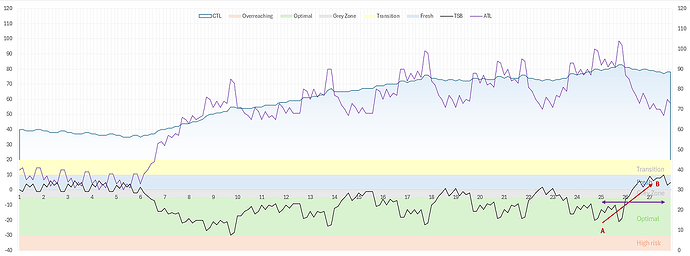For those that we questioning the taper period, using the PMC as a tool, here is my contribution. Others can weigh in as they see fit, in case I have missed anything. The example below used the generic template available in The Cyclist’s Training Bible, for someone doing 25K (annual) TSS, to get a generic list of values for daily TSS, and then calculate CTL, ATL and TSB.
First some basics:
- The PMC a graphical representation of what work has been done over a period of time, both short term impact (ATL) and longer term impact (CTL). It can also be used to calculate into the future to see what/how planned training could impact your future events.
- It uses a basic principle of increasing training load by about 7-10 TSS per day, or 50-70 per week, as a general guide to avoid overreaching. This is actually above average, and older cyclists, and lesser trained would be about half that value.
Below is the breakdown of the daily load, and the effect it has on CTL, ATL and TSB. The taper allows one to get rid of the fatigue that has been built up over the previous 24 weeks on a traditional periodized training plan. The goal of the taper is to get to race day “fresh” (TSB is 0-10, positive). As you can see, at the end of the first week of Taper, you are still carrying the fatigue from the previous 7 days (the “constant” value used in the formula for ATL. It only drops to a zero value on Wednesday of the second week. To prevent it from going too high (positive value) the workouts in the Taper period is not recovery, but high quality workouts at reduced volume. There might be more recovery days, but the harder days are more race-like efforts.This keeps the fitness from dropping too fast and the legs becoming lazy/lethargic.
The taper starts at (A) on the top chart, and aims to get you to B a few days before race day, while still “keeping the pencil sharp” during the taper period. During the taper, you would still be doing quality workouts, of the intensity you’d expect on race day, but not so much that you need “weeks” to recover.
So the initial question was why 14 days, why not 11 days or 16 days. In a traditional “out the box” periodised plan, if everything went according to plan, then it is about 12 days for the TSB to get to about 5-10. This is when someone is “on form”, and could hold it for a few weeks. Even MvdP struggled to hold form for 3 weeks in a row (RVV, PR and AG races) as we saw last weekend.
The answer was in the next question, that being “Does the amount of tapering needed depend on how much training has been done?” Yes, it does depend. The purple arrow from week 25-27 is the time axis (in days) and the red arrow (the taper) from A-B will change depending on how the balance of load is between acute (ATL) and chronic (CTL).
I have got it wrong a few times over +/- 20 years of racing, with some reasons being:
- Not understanding how to read/interpret the PMC
- Thinking taper means recovery
- Not trusting that doing less results in more
- Trying to squeeze in more, when thinking I hadn’t previously done enough.
Hope this helps.

